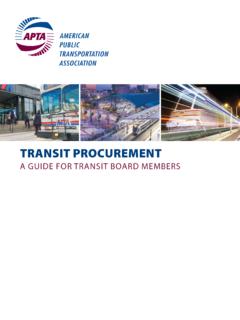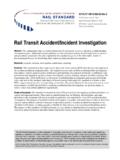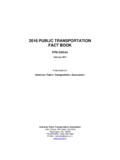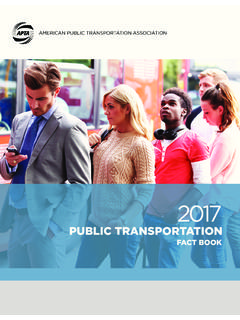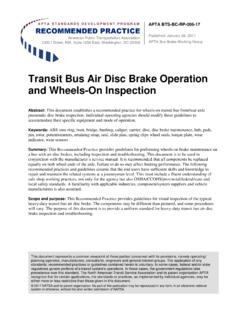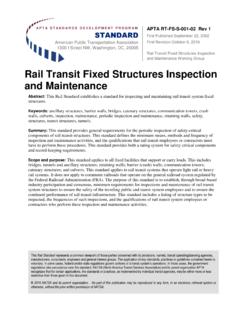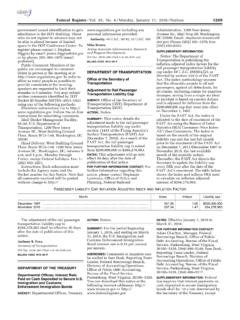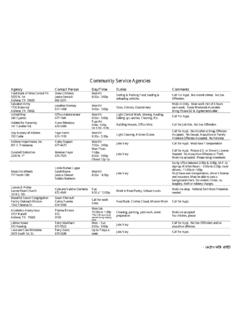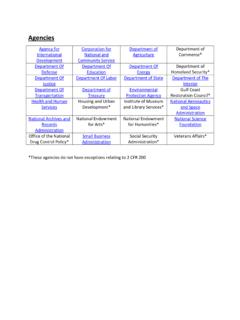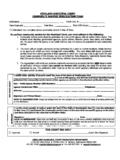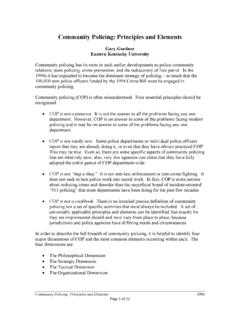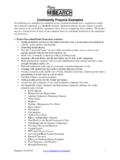Transcription of HANDBOOK for IMPLEMENTING a SERVICE …
1 HANDBOOK for IMPLEMENTING a SERVICE . quality PROGRAM for TRANSIT agencies . Rev. 11/2011. 1. APTA's Vision Statement Be the leading force in advancing public transportation. APTA's Mission Statement APTA serves and leads its diverse membership through advocacy, innovation, and information sharing to strengthen and expand public transportation. Prepared by Michael Smith, Program Manager Safety & Security (202) 496-4857. Greg Hull, Director Security & Operations Support (202) 496-4815. In partnership with APTA quality SERVICE Task Force Co-chaired by Fred Gilliam and Richard Ruddell 2. Table of Contents Organization .. 4. Background .. 5. APTA Task Force .. 6. 7. Steps .. 11. Planning .. 11. Controlling .. 17. 21. Sample Checklist .. 23. Appendices.
2 26. Appendix A: APTA Recommended Practice for Developing a Customer SERVICE Culture, .. 26. Appendix B: Leading practices of process management .. 33. Appendix C: Eight quality management principles of the ISO 9000 family .. 34. Appendix D: Malcolm Baldrige Tool, Are We Making Progress? .. 39. Appendix E: Core Measures Tables .. 43. Appendix F: Why customer satisfaction efforts fail .. 46. References .. 47. Suggested Reading .. 47. 3. HANDBOOK for IMPLEMENTING a SERVICE quality PROGRAM. Organization In support of the American Public Transportation Association's (APTA) objective to continually improve and promote quality within the transit industry, this document aims to guide the user through the implementation of a SERVICE quality program or management system.
3 The guidelines described in this HANDBOOK will enable transit management, the project team, stakeholders, and all others involved in the implementation, to develop a quality program that is consistent with (for guidance purposes only) the International Organization for Standardization (ISO) 9001 standard, and entirely focused on enhancing the customers' perception of quality . This HANDBOOK is organized in two chapters: 1- Background: Introduces the basic concepts of SERVICE quality , particularly how it pertains to the industry Outlines relevant research and materials from APTA, the Transit Cooperative Research Program (TCRP), and external sources 2- Steps: Introduces a basic framework for guiding an agency through the following phases of a SERVICE quality program: Planning Controlling Sustaining Following these steps ensures that the project or program is consistent with the principles of ISO 9001, focused on the customer experience, and specifically tailored to address the agency's needs and objectives.
4 A sample checklist derived from these steps is also offered at the end of this section, on page 22. The appendix section features various tools that may be useful in an agency's efforts to implement a quality program. The tools presented are intended to serve as a starting point for each agency to develop its own techniques. They include: APTA Recommended Practice for Developing a Customer SERVICE Culture Eight quality Management Principles of the ISO 9000 Family Malcolm Baldrige Tool, Are We Making Progress? . Core Measures Tables 4. Background The introduction of a new management philosophy called Total quality Management (TQM) during the second half of the 20th century challenged businesses and firms to completely refocus objectives, business processes, and organizational cultures in order to advance and sustain quality .
5 This scientific approach to quality formed the basis for the first suite of International Organization for Standardization (ISO) quality assurance models, which required participating companies to accurately measure performance and integrate results with high level decision-making. While the initial emphasis of the quality movement was focused on private sector manufacturing and retail operations, today, an increasing number of industries are participating, including public transportation. APTA aims to support ongoing efforts in the industry to improve and sustain quality , and to develop consensus-based, standard guidelines from which an agency or SERVICE provider may develop its own individual quality programs or initiatives. As in other industries, successful transit organizations recognize the importance of achieving high quality SERVICE , and have a strong focus on achieving this goal through careful planning, process control, and a commitment to customers.
6 As increased accountability and external demands for results become more prevalent in the industry, organizations now recognize the importance of continuous improvement frameworks. This set of guidelines aims to provide such a framework that can be adapted according to an agency's ever changing needs and objectives. Additionally, these guidelines enable agencies to develop a quality program that is consistent with the ISO 9001 standard, which has been regarded by APTA to most closely reflect the industry's customer- SERVICE focus. ISO 9001 certification1 has already been obtained by many suppliers to the transit industry and by several transit agencies ( , Utah Transit Authority, Brussels STIB, Toronto TTC's Safety Department, and Chicago CTA's Construction Management Department)2.
7 Note: While this publication is neither endorsed by ISO nor an attempt to substitute ISO's certification process, it is intended to serve as a resource for transit agencies that is guided by the principles of the referenced standard. See the ISO website for more information on the quality management standard, at: 1. See for more information on ISO certification. 2. Review of quality Programs: Final Report. PSTG Consulting & Brendon Hemily Associates 5. APTA Task Force Through discussions held at the March 2005 meeting of the chairs of APTA's Bus and Paratransit committees, it was determined that the promotion and advancement of quality SERVICE was vital to the transit industry. The initiative was subsequently expanded by the APTA Executive Committee to include all modes of transit.
8 A Task Force was formally established to determine how particular strategies might be developed to support this issue. It also established the following definition for quality as it pertains to the transit industry3: quality SERVICE is determined through the perceptions, experiences and expectations of our customers and is based on how well the SERVICE matches what is promised and communicated to the public. quality SERVICE is also determined by how well the SERVICE adapts to the changing needs of customers and the community that the organization serves and in support of ridership growth. To further define quality SERVICE as a function of the customer's perspective, several critical elements were established, including: Knowledgeable, friendly, responsive employees.
9 Convenience and accessibility of SERVICE ;. Reliability, safety, and security of SERVICE ;. Cleanliness / physical appearance of SERVICE ;. Effective and timely recovery when SERVICE is disrupted;. Provision of accurate, accessible, and timely information; and Development of a workplace environment that values and respects its employees and their role in the delivery of quality SERVICE . 3. quality SERVICE Memo. APTA. September 25, 2005. 6. TCRP. The efforts to enhance SERVICE quality programs in transit have been made possible by inter-agency dialogue and collaborative research. APTA's approach, with the support of publications by the TCRP, encourages the development of quality in transit. A. key premise that has emerged from the research is that quality programs are focused in one of two categories: 1) organizational improvement; or 2) direct SERVICE improvement4.
10 Thus, an agency must distinguish organizational quality from specific focuses such as SERVICE quality , in establishing its big picture quality objectives 5. While each initiative may be coordinated to support TQM or the organization as a whole, APTA's scope for the purposes of this HANDBOOK consistent with the TCRP reports and Task Force recommendations addresses SERVICE quality specifically. Several TCRP reports highlight the need for each agency to redefine quality in terms that are consistent with the customers' perceptions, as opposed to terms which are driven by the management's objectives. The TCRP's Transit Capacity and quality of SERVICE Manual reiterates this focus in its baseline definition of quality of SERVICE : The overall measured or perceived performance of transit SERVICE from the passenger's point of view 6.
